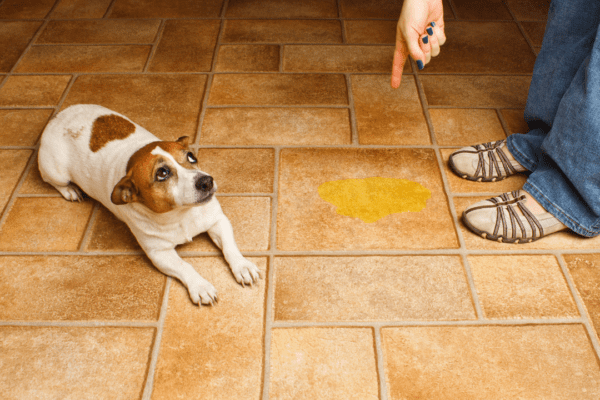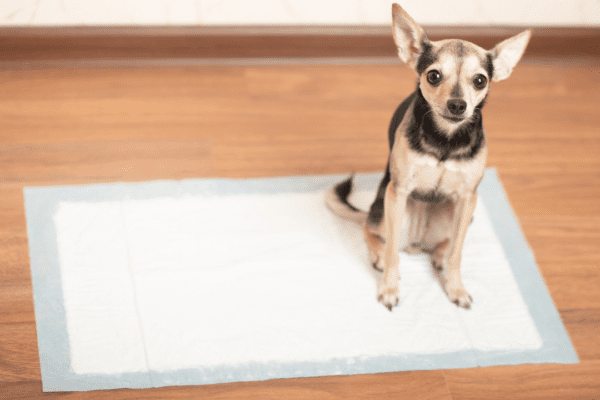
Are Dog Belly Bands the Best Choice for Your Pup?
Dog belly bands have been promoted as an easy way to deal with dog pee problems in the house.
However, depending on the cause of your pup’s pee problems, belly bands can make the original problem worse, or even cause new problems!
It’s important to understand what can cause your dog’s pee problems to determine if your dog really needs a belly band. And, if you discover they do need to wear a belly band, it’s important to know how to use it correctly and safely.
What Is a Belly Band for Dogs?
Dog belly bands are made out of fabric or diaper material. They are used on male dogs to catch urine.
As their name implies, they wrap around a male dog’s belly so when he pees, it collects on the band, much like a diaper does. Because a female dog has different anatomy, belly bands don’t work on them.
Some pet parents use dog belly bands when their dog has problems with house training, territorial marking, or urinary incontinence.
But are dog belly bands the best way to help your dog with these issues?
Why Do Some Pet Parents Like Dog Belly Bands?
If a dog has a problem with house training, dog belly bands may seem like an easy and convenient way to stop accidents.
Other dogs have issues with urine marking or territorial marking in the house. If that happens, pup parents may see a dog belly band as a quick and effective solution.

Urinary incontinence is another cause of “accidents” in the house. Pet parents may like that dog belly bands help catch the leaks that can happen in that situation.
However, if they are not used properly – or if they’re used for the wrong reasons – they can cause more harm than good.
Are Dog Belly Bands a Good Way to Stop Accidents in the House?
This depends on what is causing your dog’s accidents.
They could be caused by:
- House training issues
- Urine marking
- Urinary incontinence
House Training and Urine Marking
If house training issues or urine marking is the culprit, belly bands are not your best option.
Why Belly Bands Aren’t the Solution
Don’t get me wrong, they definitely will keep your dog from peeing on the floor, but they won’t help the underlying problem. In fact, they are likely to make it worse.
That’s because house training and urine marking problems are usually behavioral or emotional problems. If the behavioral or emotional issue isn’t addressed, your dog will continue to have problems. And then you’ll be stuck using belly bands forever!

You want your pup to know that urine marking and peeing inside the house are not acceptable. That is, they need to know the house is not a bathroom.
When you put a belly band on them, you’re telling them “now it’s okay to pee inside the house.” You’ve made the house a bathroom again. This can be very confusing to your dog, and they never learn where you want them to go.
How to Deal with House Training and Urine Marking Problems
If a previously house-trained dog starts regularly having accidents, the first thing you want to do is speak to your veterinarian. There may be a medical reason for the problem.
Once medical reasons have been eliminated, it’s time to move on to behavioral and emotional issues that may be causing the problem. It may sound daunting at first, but you absolutely can help your dog and get back to a pee-free home.
Dealing with pee problems can be incredibly frustrating. Believe me, I’ve been there.
When we were housebreaking Tulip (which took about 9 months), I couldn’t believe how hard it was to housebreak her. We tried everything – puppy pads, taking her out every 30 minutes, you name it.
I couldn’t imagine having a dog that wasn’t housebroken, but I still decided not to use belly bands or diapers even though it might have been more convenient for me. I wanted to figure out what was best for Tulip.

I also wanted to help other pet parents who had similar pee problems with their dogs. That’s why I wrote the book about it!
I also wrote multiple posts to help pet parents who are dealing with these issues, from house training a new puppy to stopping your dog from peeing in the house to ending your dog’s urine marking.
I even made my own enzyme cleaner to help pup parents dealing with the aftermath of their dogs’ accidents.
While it definitely takes more time and energy in the short term, dealing with the root of your dog’s pee problems will save you far more time, energy, and frustration in the long term.
Urinary Incontinence
As I mentioned above, if your dog was previously house-trained and starts having accidents, the first thing you want to do is talk to your veterinarian. Urinary incontinence can be caused by many different medical issues and even emotional issues like anxiety. Your veterinarian can help determine if a medical reason is to blame and what treatment your pup might need.

Some common medical causes of dog incontinence are:
- Urinary tract or bladder infection
- Weak bladder sphincter (common in senior female dogs)
- Consuming too much water
- Spinal cord issues
- Hormonal problems
- Urinary stones
- Prostate disorder
- Diabetes
- Kidney disease
- Cushing’s disease
- Congenital abnormalities
- Certain medications
Since some causes of urinary incontinence can’t be cured, your veterinarian might recommend a belly band or dog diapers for your pup.
Pin me!

What Are the Cons of Dog Belly Bands? Can They Be Used Safely?
As mentioned above, dog belly bands are not a good solution for house training or urine marking problems. They may help the symptoms, but they don’t fix the underlying problem.
If you are using dog belly bands to help with a medical condition like incontinence, there are still potential problems you’ll need to know about. This will help you use them correctly and protect your dog’s health.
1. Urine Burn or Scald
You will need to change the belly band as soon as it is soiled to prevent urine burn. This painful condition happens when urine stays on your dog’s skin for too long. Even if you don’t think your dog has soiled the band, you should change it every 3 hours or so.
2. UTIs
Bacteria can grow in a soiled belly band or diaper. This can lead to a urinary tract infection. Changing them frequently and keeping your dog clean will help.
3. More Frequent Bathing
Since urine will be in contact with your dog’s fur, they will need more frequent bathing to prevent urine burn or smelling like stale urine. This also helps prevent bacterial growth which can cause infections.
4. Skin Irritation
The band itself may cause skin irritation if put on too tightly or if your dog wears it for too long at a time.
5. Cleaning Belly Bands
Depending on the material your dog’s belly band is made of, it can be difficult to clean. You’ll want to wash it separately from your other clothing or household items.
The Tail End
If used correctly, dog belly bands can be a useful tool for dogs struggling with certain medical issues. However, for dogs that are having house training or urine marking problems, they are not the best solution and could even make the problem worse.
We all want our dogs to live happy, healthy lives. We also want to enjoy sharing our lives with them. By addressing any medical or behavioral issues behind our pups’ pee problems, we can make sure everyone in our family lives their best life.
Would you like to learn more about how to stop your dog peeing inside the house for good? Then click below to download your FREE copy of my ebook!








Kristen, you have made the excellent constructive points in the article. Do you think the pup’s pee problems can be related to emotional issues due to rehoming? If it is true, then the belly band can exacerbate the situation. What do you think?
Hello Jack,
Pee problems can definitely be related to anxiety, and anxiety can definitely be caused by rehoming.
Finding the root cause of your pup’s pee problems is the best way to help.
You can find more info on causes and solutions to common pee problems in my free Ebook.
Kristen
Thank You, Kristen. I really appreciate your effort.